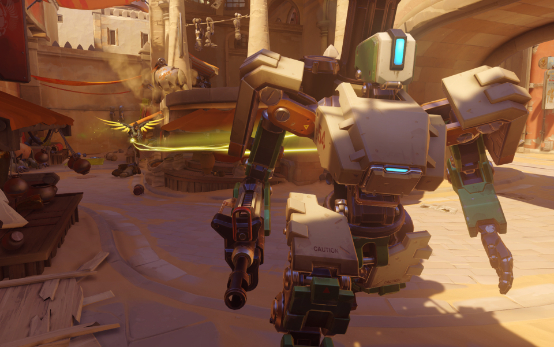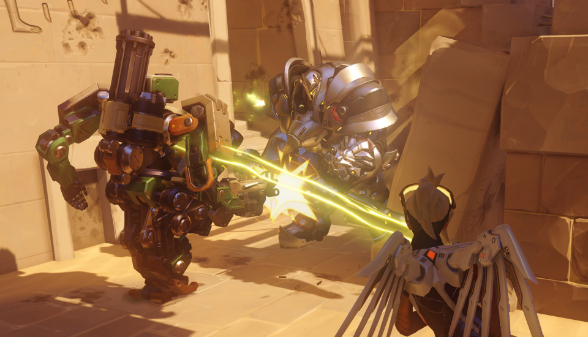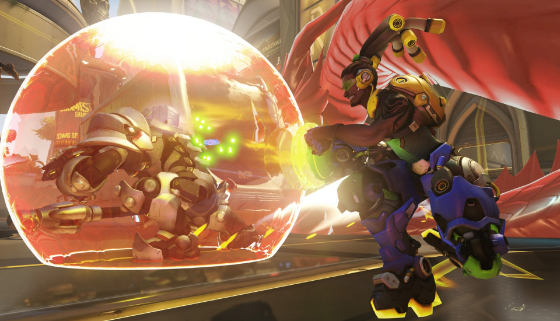If Overwatch stands as proof of anything, it’s that Blizzard is undoubtedly a company that can spin any genre they touch into gold. From the Real-Time Strategy titles and Action-RPG’s they began with in the Warcraft, StarCraft, and Diablo franchises, to the more recent offerings of an MMO, a card-based action game, and a MOBO with the likes of World Of Warcraft, Hearthstone, and Heroes Of The Storm respectively – their first foray into FPS territory is yet again another monumental feat for the legendary developer. Encapsulating all the qualities that are so great about team-focussed action games and blending them with the classic Blizzard magic, Overwatch is a fantastic First-Person Shooter that doesn’t necessarily reinvent the wheel, but rather refines the qualities we all know and love into one tidy, cohesive package.
In a sense, Overwatch is able to shine by taking the gameplay back to its basics. Though it certainly adds its own flavour into the mix through its other aspects, it’s a game that, at its core, operates similarly to the popular arena shooters of old. Instead of requiring a precise-level of player accuracy for the most part, being littered with killstreak rewards, focussing on XP gains and boosts, and necessitating stealthy play to gain the upper-hand – this is a game where you are encouraged to thrust yourself into the thick of it, and go in loud and hard. Battles are chaotic in the best sense, the action is of a high-speed, and there is a high-intensity to all of the proceedings that elevates the gameplay to great heights. This is a fun, imaginative, competitive shooter that brings out the best of arcade-style video games, and is able cement itself as something special within the current, and dulled gaming landscape.
Doing away with traditional and customisable player loadouts, Overwatch features 21 totally unique characters that fit into one of four distinct character classes: Offense, Defence, Tank, and Support. Emerging as part of the so-called ‘hero shooter’ trend, each character features not just character-specific weapons and gadgets, but also character-specific abilities too. Best described as “Team Fortress 2 meets League of Legends”, there’s a distinct MOBO-like quality to the gameplay as players have to utilise pre-determined move sets, work around cooldown meters, and build up to devastating special plays. The characters of Overwatch really are the biggest starts of the show, and it’s remarkable to see how Blizzard have carefully designed and implemented each character without even a single blemish. There’s a Cowboy, a Ninja, a Gorilla, and a Dwarf thrown into the mix, and that’s only the tip of the iceberg for what this game offers. Despite the huge differences between them all, they’re all really well balanced, and each a worthy addition to the roster.
Some may argue that each character is fairly limited in their ability sets, but this doesn’t make for boring gameplay – in fact, it’s far from it. Because of how broad the variety is amongst the games cast, fighting never feels dull, and the interplay created between you and your teammate’s capabilities ensures plenty of room for tactical plays on the battleground, and refreshing enemy encounters. Not only this, but players can actively switch between heroes whenever they want within the spawn area to spice things up, or to better adapt to the ever-changing battle scenario. There is a clear focus with all the characters that ensures they do just enough without becoming too complicated, and as a result it makes Overwatch feel incredibly accessible. Though some characters are notably harder to play as than others – and will take a lot of practice to maximise their usefulness – they all have their own purpose and can complement each other perfectly.
Blizzard has never been one to cut corners on creativity, and it certainly shows here as even though some of the characters echo typical class identities, they still feel unfamiliar and exciting to play as regardless. Given just how many creative mechanics and abilities are offered by each character, the game presents the player with many options. As a result, the game comfortably caters for any potential playstyle. Do you fancy heading straight into the action and getting all close and personal? Reaper, D. Va, and Roadhog have you covered. Are you an experienced distance shooter? Then Widowmaker and Hanza are exactly who you might want to pick. Or, perhaps you enjoy supporting your team and helping to reinforce your line of defence? Well then, you’ll probably want to choose from Reinhardt, Mercy, or Torbjörn. The aforementioned character lists are not exhaustive of course, with many more characters to choose from, but the point is that Blizzard have provided for a variety of situations and player needs, and they’ve massively succeeded in this respect.
This grand level of quality is thankfully mirrored onto the rest of the game too, with the maps in particular being yet again another strong display of what the development team are capable of. With an impressive 12 maps in total, each are based within a real-world country and breathe an exceptional amount of character, as well as being incredibly fun to play in. Though the majority of the available maps are set within urban environments, the incredible detail and cultural influences that ooze out of each set make them stand out amongst their counterparts. The actual map design itself is also exceptional, with elements taking into account and catering for character abilities, and with several key areas/routes to attack and defend from. Each map is also well suited to the objective-based game modes too, of which there are four:
- Escort – the Attacking team have to capture and escort the payload to its destination, while the Defenders must repel the attack and halt their progress.
- Assault – Attackers and Defenders must take or defend two specific points of the map within the time limit to achieve victory.
- Control – both teams fight for the full acquisition of a single capture point, set within a best-of-three format.
- Weekly Brawl – a special weekly event that offers a specific game mode that’s “featuring a set of unique (and sometimes crazy) rules”. In the context of the Open Beta period, this mode ran a “Mystery Hero” event that, as the name suggests, gave the player a random hero to play as on each spawn.
While the low amount of game modes would otherwise be criticised, in the case of Overwatch, the ones available felt like more than enough and felt fairly timeless, at least for the time being. Due to the plentiful maps, their thoughtful design, and the large character roster, there’s enough variety at play to ensure that no single match ever feels the same. Where my concerns do lie, however, is in how the community will be sustained after the full launch. Though there is a levelling system in place, this only contributes towards the increase of your status and the unlocking of random cosmetic items from within ‘Loot Boxes’. While costumes, voice lines, and sprays (graffiti that can be ‘tagged’ around the environments) are a nice addition, the lack of any unlockable gameplay-centred content may result in a declining player base a while after launch. That said, a competitive mode will arrive when the game launches at the end of the month, and Blizzard has previously stated that all post-launch content would come free of charge – which is great news for all, I’m sure.
It’ll be interesting to see how invested the player base becomes when the full-release is upon us, and how the game grows over the course of its lifespan, but it’s certainly clear at this point that Overwatch will have a significant hold of the gaming world in 2016 (and hopefully beyond). As far as multiplayer shooters go, this is easily one of the best I’ve played in a long time, and I’m itching to jump into the full-game when it arrives on May 24th.














You must be logged in to post a comment.